|

Brazil is much more than the country of soccer, samba,
and bossa nova, of the Amazonian and Pantanal regions
and the beautiful beaches.
We are almost 190 million Brazilians and immigrants,
and form one of the most fascinating countries of the planet,
connected by one single language – Portuguese, on
an area of more than 8.5 millions square kilometers, crossing
the Capricorn Tropic and the Equator. A country that respects
and values the culture of men and women of all ethnic groups,
nationalities, religions and cultures, which merged in
order to form just one people – the Brazilian people.
With a Gross Domestic Product of approx. US$795 billions,
Brazil is one of the big economies in South America, producing
state-of-the-art technology, especially in the areas of
aerospace technology, medicine and IT.
Many Brazilians stand out in the international scenario.
Pelé and Ayrton Senna in sports; Tom Jobim, Os Mutantes
and Caetano Veloso in music; Jorge Amado and Paulo Coelho
in literature; Cândido Portinari in painting; Carmem
Miranda and Glauber Rocha in the movies industry; Rui Barbosa
in politics; Oscar Niemeyer in architecture and Santos
Dumont in aviation, among many others!
Despite being a young country, Brazil stands out in many
areas, with technology pools, universities, industrial
areas, TI, communication and aeronautic companies … everything
is present from North to South over the country. From the
countryman to the businessman, from agronomy to aerospace
engineering, Brazilians are connected to the newest technology
and knowledge in the world.
In the transition between the nice spring and the warm
summer, Brazil will host the ICANN Meeting São Paulo, gathering
all nations on an occasion of enormous joy.
Know more about Brazil in:
Brazilian Regions
Brazil is divided in five geographic regions: the North,
Northeast, Center-West, Southeast and South. Know more about
each one of them:
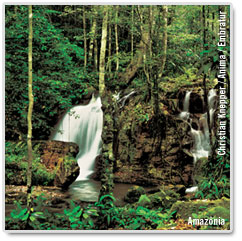 The Northern Region The Northern Region
Geographically, the Northern Region is the largest one of
Brazil, with more than 3,000,000 km 2. The region covers 45.28%
of the national territory and includes the biggest portion
of the Brazilian Amazonian system. The cities in that region
are isolated from each other due to the region's low demographic
density. The States Acre, Amapá, Amazonas, Pará,
Rondônia, Roraima and Tocantins constitute the Northern
Region.
From the cultural perspective, this is a very rich area.
In the State Amazonas, the Folkloric Festival of Paritins attracts
thousands of visitors in June. Since 1793 Belém (the
capital city of the State Pará) hosts the Círio
de Nazaré feast, a popular celebration in honor to Our
Lady of Nazaré, which gathers two million people every
year.
The largest river in the world crosses the largest forest
in the world. The Amazonas River, with an extension of 6,868
km, crosses Peru and Brazil and has a water volume 56 times
bigger than the Nile River. In Brazil, the river flows through
two States: Amazonas and Pará, ending in the Atlantic
Ocean near to the Marajó Island.
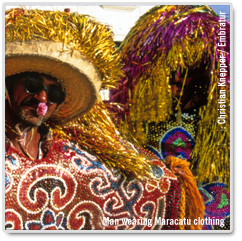 The Northeastern Region The Northeastern Region
Intense heat, beautiful beaches and the hospitality of the
northeastern people are the major features of that region.
From Bahia to Maranhão, a kaleidoscopic mixture of believes,
races and cultures fascinates every visitor to those states.
Brazil was born in the northeastern region, since the Portuguese
landed in Bahia, in 1500. Africans, native Indians and Portuguese
made the city of Salvador the capital of the new colony. During
the next centuries, Dutch and French men tried to invade the
region and left their influence in the culture and typical
accent of people of that region.
The northeastern region receives millions of tourists looking
for its natural and cultural beauties. Olinda, São Luís,
Lençóis Maranhenses and Fernando de Noronha are
a few examples of the main tourist destinations in the country.
And everything with lots of music and unique cooking!
The northeastern States are: Alagoas, Bahia, Ceará,
Maranhão, Paraíba, Piauí, Pernambuco,
Rio Grande do Norte and Sergipe.
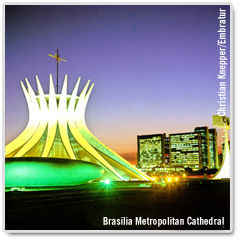
The Center-West Region
This is the land of the typical Brazilian countryman. The
inner land culture of Brazil goes through the States of Mato Grosso, Mato Grosso do Sul and Goiás. Brasília,
the capital of Brazil and the Federal District, was designed
by Lúcio Costa and Oscar Niemeyer and is also located
in that region.
Between the calm rhythm of Pantanal and the agitated life
in Brasília, there is a people who loves its land. This
region is also responsible for the largest portion of the Brazilian
cattle industry. The music with roots in the simple man's life
always delights attentive listeners.
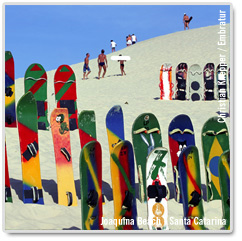 The Southern Region The Southern Region
Three states form the southern region of Brazil: Paraná,
Santa
Catarina and Rio
Grande do Sul. Those states are nationally
known for the high concentration of German and Italian immigrants,
who keep and preserve the traditions of their countries of
origin until today; but, like it happens in the other places
of Brazil, everything is merged with some ingredients of other
people.
In Santa Catarina, the beauty of the beaches in Florianópolis
convinces all tourists to stop and stay. Gustavo Kuerten, the
world tennis champion, was born in Santa Catarina.
Rio Grande do Sul has a people who are very proud of their
state. The gaucho was always present in the most important
decisions of the country, from politics (with Getúlio
Vargas, the president of Brazil during the II World War)
to soccer (with the Grêmio and Internacional teams).
People of Rio Grande do Sul is easily recognized by their accent
and charming hospitality.
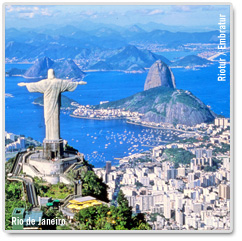
The Southeastern Region
Rio de Janeiro, São Paulo, Espírito Santo and
Minas Gerais belong to the richest and most developed region
of the country. The most important business transactions, the
most intense cultural life and the largest populations are
in the Southeastern Region.
Since the Garota de Ipanema (Girl From Ipanema) appeared
and became famous, Rio de Janeiro is Brazil's entrance door
to the world. The reign of bossa nova and Carnaval,
the city enchants everyone.
Minas Gerais has been the land of gold, diamonds and many
different kinds of mineral richnesses, which were extracted of
the soil of this state during the colonial period. During that
period one of the most important sculptors, Antônio Francisco
Lisboa, the Aleijadinho (The Cripple) arose in Minas
Gerais. Many of his art pieces can be seen in the streets of
Ouro Preto. Observing the sky in Minas Gerais, Alberto Santos
Dumont invented the airplane 14-Bis, and became the first man
to take off with an aeronautic engine.
São Paulo has more than 40 millions inhabitants and
doesn't stop growing. The country's economy goes through the
State, whether in the cattle industry, or in the industry at
large or even in the service sector. The explorers called Bandeirantes left
São Paulo in order to discover the inner land of Brazil,
followed by Italian and Japanese immigrants, who work on the
fertile soil of the State until today. The capital of the State
will host the ICANN Meeting São Paulo. |